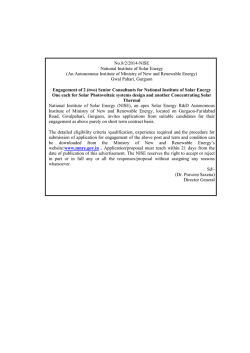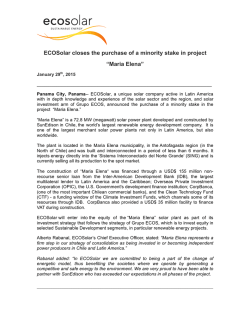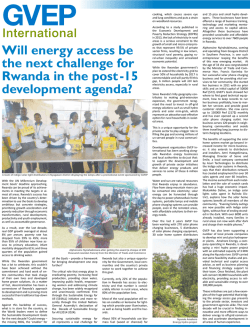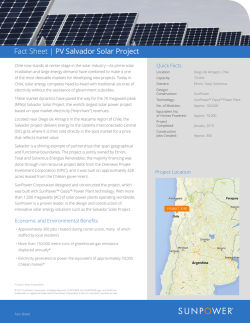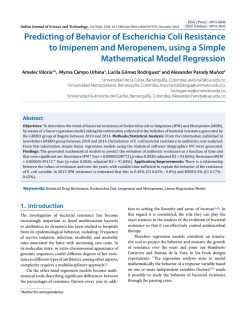
Transfer of Bacteria via Vapor in Solar Desalination Units
TRANSFER OF BACTERIA VIA VAPOR IN SOLAR DESALINATION UNITS G. M. Ayoub1, L. Dahdah1, I. Alameddine1 1 Department of Civil and Environmental Engineering, American University of Beirut, P. O. Box Riad el Solh, Beirut 1107 2020, Lebanon Presenting author: [email protected]; +9613446308 Abstract Microbial contamination of drinking water is a major public health threat worldwide. Some studies have reported unusual findings of microbiological contamination in distilled water produced from solar stills. Not knowing the exact reason for this presence, they attributed it to possible cross contamination. In the complete absence of literature on the transfer of bacteria in solar stills, this research was conducted to investigate whether bacteria in water subjected to low temperature solar desalination finds its way into the effluent as a result of cross contamination or transfer through water vapor. This study looked at how the type of bacteria and the water temperature affected transfer in the absence of solar UV radiation. Simulated distillation experiments performed in darkness were conducted by spiking a pure culture of Escherichia coli or Enterococcus faecalis in tap water and heating it to low temperature ranges similar to those reached in solar stills under real sunlight. Results show that the two types of bacteria tested in the study were transferred with the vapor in a solar still when not exposed to solar UV radiation and that transfer at the 40-45°C range is significantly higher than transfer at other temperature ranges. Moreover, transfer is independent of bacterial type; however E. faecalis transfer rates are higher than E. coli at the 40-45°C and 50-55°C ranges. While solar desalination can effectively inactivate bacteria in water, there exists a mode of transfer of bacteria in the humid medium of the solar still to the distillate that takes place when the conditions are right. Keywords Water contamination; low-temperature distillation; bacterial transfer; water vapor 1 I. INTRODUCTION Microbial contamination of drinking water is a major public health threat worldwide. In developing countries, the problem is more severe as a result of poor water distribution networks and limited funding for water treatment systems. While it is important to treat water at the source, it is not guaranteed that the water treated will arrive to the end user free of microbial contaminants as opportunities for recontamination during transmission and storage exist [1]. Solar still distillation is a point-of-use water treatment technology that can provide fresh water for communities in remote locations with poor water quality and quantity sources and ample amounts of sunlight [2], or ones that had their water supply cut off because of natural disasters or unexpected accidents [3]. Unlike other energy-intensive desalination technologies, solar stills have desirable features such as their low cost, ease of construction, minimal operation and maintenance requirements, and utilization of renewable energy [4]. Figure 1 shows the schematic of the simplest, yet most practical, type of solar still which is the passive single-basin solar distiller. It comprises a shallow air tight basin where the potentially contaminated water is filled and allowed to heat up utilizing solar energy or a regular energy source. Solar radiation transmitted through the cover increases the temperature of the water and after surface water develops enough kinetic energy to escape the surface tension of the liquid, it begins to evaporate leaving contaminants in the basin. The warmed water vapor rises and is captured on the underside of a cooler transparent cover were it is allowed to cool and condense back to the liquid state to form droplets that trickle down, by gravity, to collection troughs as fresh water. Figure 1: Schematic of a passive solar still Theoretically, the evaporation-condensation process inside solar stills is believed to remove solids, heavy metals and microbiological contaminants from the water. However, few studies have actually reported the microbiological quality of the distillate in passive solar stills [5-9], with some studies reporting bacterial presence in the distillate after the distillation process [10-12]. As such, the subject of bacterial transfer through vapor is still an active area of research. No studies, to our knowledge, have eliminated solar UV radiation to study whether there is a mode of transfer for bacteria in a solar still, therefore, absence of bacteria in the distillate can either be attributed to inactivation by UV radiation or to the absence of a transport medium. Consequently, the mode of transfer of bacteria from water to air in the humid atmosphere of a still has not yet been resolved since there is limited supporting evidence in the literature on it. The study aims at investigating whether bacteria in water subjected to low temperature solar desalination finds its way into the distillate as a result of cross contamination or transfer through water vapor. The variables altered and tested in the study were the type of bacteria and water temperature in the absence of solar UV radiation. First, passive single-basin solar still units were constructed, and then experiments were conducted by using two different 2 types of bacteria (Escherichia coli and Enterococcus faecalis) in dechlorinated tap water at the low temperature ranges (30-35ºC, 40-45ºC and 50-55ºC). II. MATERIALS AND METHODS Four lab-scale, hemispherical, single-basin distillation units were constructed. Each still mainly consisted of a circular basin, a hemispherical dome and a distillate collector (Fig 2). The basin had an area of 433.5 cm2 and a working capacity of 500 ml of water, while each dome had a surface area of 905 cm2. The hemispherical domes were made out of polycarbonate (PC) plastic because of its light weight, low cost, and durability, and hence, were found convenient for handling in the lab. Into each unit a trough, bypass tube and distillate collector were built. The solar still efficiency, calculated based on the method adopted in Flendrig et al. (2009), was 14.5% [9]. To ensure that the distillation units were free of any bacterial contamination before each experiment, they were cleaned with labgrade detergent, rinsed with ethanol, disinfected by ozonation using a Microzone 300 (ClearWater Tech, USA) and then subjected to ultraviolet light from two 15-Watt TUV G15 T8 Philips germicidal sterilamps. Pure cultures of two bacterial strains, Escherichia coli ATCC 25922 and Enterococcus faecalis ATCC 51922, usually found in fecally-contaminated water were chosen for the study. E. coli are lactose fermenting, gram negative, rod shaped bacterium 3 μm long and 1 μm wide. A member of the fecal coliform group of bacteria, E. coli is a microbiological indicator associated with the presence of disease-causing organisms in water. It is thermo-tolerant and can grow at a wide range of temperatures between 7.5°C - 49°C with an optimum temperature of 37°C [13]. One gram of colon material generally contains around 106 E. coli cells that could end up in water sources as a result of fecal deposition. Outside the host, various stresses such as high and low temperatures, UV radiation, limited moisture and lack of nutrients affect the viability of this bacterium; however, they have the ability to survive for extended durations of time in water in temperate, favorable climatic conditions [14]. E. faecalis are gram positive, facultatively anaerobic fecal indicator bacteria that are more human-specific than the larger streptococcus group. They have the ability to survive harsh environmental conditions like extreme alkaline pH of 9.6, prolonged nutritional deprivation and high salt concentrations [15]. These cultures were provided from the American University of Beirut Medical Center (AUBMC) – Microbiology and Parasitology Laboratory, Beirut, Lebanon on inoculated plates and preserved in glycerol at -80°C for further use throughout the experiment. Figure 2: Schematic of the solar still used in the study For the preparation of a stock solution of Escherichia coli, a tube of frozen E. coli was thawed at room temperature under a hood and inoculated into 100 ml nutrient broth (BD Difco, USA) using a sterile stick. The solution was then placed in a rotating incubator (Thermo Scientific, USA) at 200 rpm, 37°C for 18 hours to reach stationary phase. The phase of bacterial growth was determined spectrophotometrically (E.coli: A600, 3.5) (E. faecalis: A600, 1.1) on a 3 DR/4000 spectrophotometer (HACH, USA). After 18 hrs, the inoculated broth was centrifuged in a Sorvall ST16 centrifuge (Thermo Scientific, USA) at 10,000 rpm (16,466 x g) for 20 mins; the supernatant was then discarded and the pelleted bacteria was resuspended in 20 ml sterile pre-distilled Milli-Q grade water. Centrifugation and resuspension were repeated three times to facilitate the complete removal of the growth medium. The resulting pellets were finally resuspended into 20 ml of sterile water to form the stock solution with an estimated concentration of 107 - 108 CFU/ml. E. faecalis was harvested in the same manner, but with different growth media. Serial dilutions for the stock solution were performed using the Miles and Misra drop count technique [16]. 20 µl drops of the appropriate dilution were poured on MacConkey agar plates (HiMedia Laboratories, India), or Columbia CNA agar (Deben Diagnostics, UK) with 5% sheep blood in the case of Enterococcus faecalis, in triplicate and allowed to spread. Plates were incubated for 18-20 hours at 37°C and read the next day. Bacterial count was calculated by averaging the number of colonies for each dilution, multiplying by 50 (a conversion from 20 µl to 1 ml) and dividing by the dilution factor to get the number of CFU/ml. Miles and Misra dilutions were also performed after the stock solution was suspended in the sample water (15ml stock solution was spiked into 1,500ml of de-chlorinated tap water). The sample water had a bacterial population of approximately 106 CFU/ml simulating a worst-case scenario of water contamination [17-19]. The sampling water was prepared in a batch mode and divided into the four stills. Before each experiment, swabs were taken from inside the dome and the distillate collector of each still to ensure the absence of contamination in the stills. After each experiment, grab samples were taken from the distillate collector and remaining water in the basin after 24hrs. Processing of grab samples was performed on polycarbonate filters (47 mm diameter, 0.4 μm pore size) by membrane filtration method. A total of 11 experiments were conducted; 6 for E. faecalis and 5 for E. coli at the three temperature ranges. All experiments were repeated twice and the numbers of CFU/100ml were reported as the median of sixtuplicates except the E. coli experiment at 50-55°C range which was repeated once and reported as the median of triplicates. This was due to the fact that preliminary tests confirmed that no transfer was taking place for E. coli at that temperature. Experiments were typically kept running for 24hrs to get enough distillate from the units. Heat was provided through heating mantles (Electrothermal Inc., UK) equipped with temperature controllers to more accurately control and regulate the heat and maintain constant temperatures (SD: ±2.5°C). Water temperature (Tw) and humid air temperature (Tha) variations inside the solar stills were measured by inserting two K-type thermocouples at the top of each still; ambient air temperature (Ta) was measured with an alcohol-in-glass thermometer and recorded at the start of each experiment. Thermocouples were attached to a USB Data Acquisition Module (Cole Parmer, USA) connected to a PC for continual reading of temperature (Fig 3). Since field trials have shown that temperature in solar disinfection bottles, and passive solar stills, rarely exceeds 50°C [20, 21], distillation experiments at low temperature ranges (30-35ºC, 40-45ºC and 50-55ºC), were conducted on the two bacterial types. 4 Figure 3: Setup of Thermal Experiments in EERC lab III. RESULTS AND DISCUSSION The assessment of whether bacteria gets transferred via vapor to the distillate, in the absence of UV radiation, is addressed by looking at the medians of viable colony forming units per 100 ml of distillate (CFU/100ml), and analyzing how variations in the type of bacteria and water temperatures affect the process. Bacterial count transfer data were right-skewed and not normally distributed (Fig 4). This prevented the use of typical parametric tests such as the t-test and ANOVA. As such, the data was analyzed using the non-parametric Wilcoxon rank-sum test (also known as the Mann-Whitney test) in the R statistical software. The test is used to assess if two (not necessarily normal) population distributions are identical [22, 23]. In this study, data are reported by their median followed by the interquartile range (Mdn; IQR), while differences between populations are reported by the test-statistic followed by its corresponding p-value (W; p-value). Figure 4: Probability density distribution of the bacterial transfer data 5 3.1. Transfer of Escherichia coli in Solar Stills Swabs from the dome of each still streaked on agar plates after each experiment did not show any bacterial presence. Membrane filtration tests conducted on the remaining water in the basin of the still showed slight bacterial reduction (0.7 – 1.2 log reduction) as compared to the original contamination levels when kept at temperature ranges between 30-35°C and 40-45°C. At 50-55°C, levels of E. coli were significantly reduced and most often eliminated in the basin (5.5 – 6 log reduction); consequently E. coli did not show up in the distillate during the thermal distillation experiments. This was in accordance to the findings of Padia et al. (2012), who studied E. coli survival and growth in autoclaved water inoculated with E. coli from the feces of four different species of animals kept at different temperatures and reported no survival of E. coli in the water at 50°C after 24hrs [24]. At the lower temperatures, our results from the stills were consistent with those reported by Rojko (2003), who kept E. coli in a water bath for up to 5 hours at 46°C and reported that concentrations were not reduced [25]. Note that Pope et al. (2003), who kept E. coli from different water sources in storage at 35°C for 24 hours, reported variable results ranging from no significant reduction to a 95.51% reduction in viable colonies as tested by the membrane filtration method [26]. Given these results we expected that transfer at the 30-35°C and 40-45°C temperature ranges will be higher than the transfer at higher temperatures. The transfer of E. coli to the distillate was expected to vary due to the inherent variability of the microbiological organisms. The triplicates for each experiment more often than not gave consistent counts of viable colonies transferred; yet sometimes it varied with one still exhibiting no transfer while the other two exhibiting transfer. Starting with the same initial bacterial concentration of 106 CFU/ml, transfer of E. coli under all water temperature ranges never exceeded 1,195 CFU/100ml, a 4.9-log reduction from the original count. This maximum concentration was recorded while using tap water heated to 30-35°C; however, the median transfer at that temperature range was 23 CFU/100ml (Fig 5). Bacterial densities showed that the highest E. coli transfers occurred on average at 40°C. As compared to the median number of colonies transferred in tap water at 30°C which was 23 colonies/100 ml, the median at 40°C increased to 309 colonies/100 ml. At 50°C, no transfer was recorded suggesting that water could be disinfected from E. coli in 24 hours when low distillation temperature is set to 50°C even in heavily contaminated water sources. Figure 5: Violin plots showing the distribution of E. coli for each of the three temperature ranges (white dots signify the median, thick horizontal lines the interquartile range, thin horizontal lines the whiskers & the shaded areas around the boxplot are rotated kernel densities) 6 Our findings show that E. coli indeed has a mode of transfer via water vapor in the humid atmosphere of the solar still which could have aided in the transfer of that bacteria to the distillate. Transfer of bacteria via vapor by evaporation of contaminated waters at low temperatures has very rarely been studied and reported in the literature. None have investigated whether vapor was actually transporting microbial particles in the stills, consequently, positive bacterial findings in solar stills have often been explained away in different ways. Some studies have concluded that salinity and the growth of algae and other micro-flora in the water could have affected the disinfection process in solar stills and sheltered microbial contaminants from UV radiation [27]. Hanson et al. (2004) reported that water free of bacteria may be produced by solar stills if cross-contamination does not occur. It was also hypothesized that bubbles, created by the turbulence of adding water to the basin, could have burst and formed droplets on the glass cover which contaminated the distillate [11]. Balladin et al. (1999), who investigated the quality of the distillate produced by a Concrete Cascade Solar Still by comparison with a conventional electrically powered still, reported coliform bacteria in both stills and attributed this finding to airborne microorganism contamination and low chloride concentration. While the water temperature reached inside the stills was not reported, the lower coliform counts (22 CFU/ml) inside the conventional still with respect to the high coliform counts (1400 CFU/ml) in the cascade still were explained by Balladin et al. (1999) as a direct effect of distillate temperatures in the conventional still reaching 50°C which may have destroyed a proportion of the bacterial population [10]. Another recent study by Malaeb L. (2011) also reported E. coli contamination in distilled water produced from three novel solar stills. Although the stills were exposed to solar radiation in these studies throughout the day, positive bacterial counts were detected in the distillate [13] and were attributed to possible cross contamination. 3.2. Transfer of Enterococcus faecalis in Solar Stills Swab tests taken from the dome of the stills after the end of each experiment and streaked on Columbia CNA agar did not show any bacterial presence. Original microbial counts in the basin after 24 hours did not get reduced at the temperature ranges 30-35°C. A slight reduction (1 – 2 log reduction) was observed at 40-45°C. At 50°C, a significant reduction (5 – 6 log reduction) was observed in the basin; yet E. faecalis were not completely eliminated. Our findings were in accordance with studies that have reported E. faecalis to be more resistant to heat treatment than E. coli and that the stationary phase cells of Enterococcus faecalis can survive high pasteurization temperatures of up to 65°C for 15mins [15]. However, no studies exist on the pasteurization of this bacterial species at low temperature ranges. As for its transfer to the distillate, the maximum observed concentration of E. faecalis was 3,250 CFU/100ml; a 4.5log reduction from the initial bacterial concentration of 106 CFU/ml. This maximum was recorded when tap water was heated to 40°C (Fig 6). Average values of bacterial densities show that the highest transfers also occurred at 40°C. The median number of colonies transferred in tap water at 30°C was 23 colonies/100 ml. The number increased to 2,425 colonies/100 ml at 40°C, and decreased to 28 colonies/100ml at 50°C. 7 Figure 6: Violin plot of the distribution of E. faecalis for each of the three temperature ranges (white dots signify the median, thick horizontal lines the interquartile range, thin horizontal lines the whiskers & the shaded areas around the boxplot are rotated kernel densities) 3.3. Testing Variability across bacterial type & temperature ranges Independent of temperature, our results showed that the number of viable bacterial colonies transferred in thermal distillation experiments (expressed in CFU/100ml) was higher in E. faecalis (Mdn = 36; IQR = 1,685) as compared to E. coli (Mdn = 19; IQR = 315) (Fig 7), however, the difference between the two bacterial types was not statistically significant according to the Wilcoxon signed rank test at the 95% confidence interval (W = 170.5, pvalue =0.20). Figure 7: Violin plot showing skewness in distribution of transfer data with E. faecalis showing more variability than E. coli (white dots signify the median, thick horizontal lines the interquartile range, thin horizontal lines the whiskers & the blue areas around the boxplot are rotated kernel densities) 8 With respect to the effect of temperature, contaminated water at the 40-45°C range resulted in the highest count of CFUs being transferred to the distillate (Mdn = 542; IQR = 984), as compared to water heated to 30°C (Mdn = 23; IQR = 40) or to 50°C (Mdn = 9.75; IQR = 34). This temperature dependent transfer pattern was consistent for both E. coli and E. faecalis. At 30-35°C, the level of transfer was slightly lower for E. faecalis as compared to E. coli; while at 40-45°C the trend reversed (Fig 8). At 50-55°C, E. coli was eliminated while E. faecalis still had some viable bacterial colonies with a median of 28 CFU/100ml (Fig 8). The rate of transfer between the two bacterial groups at different water temperatures was found to be significant at the 95% confidence interval. For E. faecalis, transfer levels were significantly higher than E. coli at the 50-55°C range (W = 16.5; p-value = 0.03) as well as the 40-45°C range (W = 32; p-value = 0.02) but not at the 30-35°C range (W = 15; p-value = 0.71). Due to the lack of studies on the effect of low-temperature distillation on bacterial transfers, it is not well understood why E. faecalis transfers more readily as compared to E. coli. Yet, one possible explanation for this could be that E. faecalis colonies are able to survive the transfer more than E. coli due to their relatively smaller size and higher resistivity to environmental stresses especially high temperatures [28]. E. faecalis is relatively small with an average size of 1.38 x 0.31µm in the stationary phase [29], possibly making it easier to travel with water vapor as opposed to the larger E. coli (av. 3 x 1µm) [13]. Figure 8: A conditional plot showing bacterial transfer as a function of the three temperature ranges conditional on the type of bacteria 9 The Wilcoxon test showed that the transfers that occurred at 40-45°C were significantly larger (at the 95% confidence interval) than the rates observed under the other ranges for both bacterial types (W=197.5; p-value = 0.004). Since the ideal temperature for the two thermo-tolerant mesophilic bacteria used is 37°C; heating the water at 40°C may have favored transfer. At 30-35°C, the bacteria in the basin water did not show a reduction in number; however, since the evaporation and condensation rate was low (i.e. approximately 25 ml only of distillate was collected) the number of transfers could have been reduced. At 40-45°C, the evaporation-condensation rate was higher and hence more distillate was collected (approximately 92 ml) with a higher number of bacteria. At 50-55°C, the temperature was not ideal for the two bacterial species, so although the condensation rate was high (approximately 120ml of distillate collected), bacterial survival in the basin limited the transfer. IV. CONCLUSION This research targeted the transfer of bacteria to the distillate given by three passive single basin solar stills simulating real sunlight conditions without UV radiation. Experiments were repeated with changes in the bacterial species and the water temperatures reached. Two significant findings could be deduced from this study. First, that bacteria indeed get transferred in a solar still when not exposed to solar UV radiation and the only plausible medium of transfer is the vapor. Transfer at the 40-45°C range was significantly higher than transfer at other ranges. Both the two types of bacteria tested in the study exhibited transfer or aerosolization from the basin of the still, through the vapor, to the distillate in a viable state. Secondly, transfer seemed to be independent of bacterial type with no significant difference between E. faecalis and E. coli; however, E. faecalis exhibited significantly higher CFU transfers than E. coli at the 40-45°C and 50-55°C ranges. Further research could be conducted using larger solar stills to get more distillate output per unit time and be able to draw transfer curves over time. V. ACKNOWLEDGMENT This research was made possible by funding from the National Council for Scientific Research. VI. 1. 2. 3. 4. 5. 6. 7. 8. 9. REFERENCES Clasen, T., Schmidt, W. P., Rabie, T., Roberts I, & Cairncross, S. (2007). Interventions to improve water quality for preventing diarrhoea: systematic review and meta-analysis. British Medical Journal, 334 (7597); 782. Bouchekima, B. (2003). A solar desalination plant for domestic water needs in arid regions of south algeria. Desalination, 153, 65-69. Cappelletti, G. M. (2002). An experiment with a plastic solar still. Desalination, 142, 221–227. Ayoub, G. M., & Malaeb, L. (2012). Developments in solar still desalination systems: a critical review. Critical Reviews in Environmental Science and Technology, 42(19), 2078-2112. Schwarzer, K., Vieira, M. E., Christian, F., & Muller, C. (2001). Solar thermal desalination system with heat recovery. Desalination, 137, 23-29. Medugu, D. W., & Malgwi, D. I. (2006). Design and development of solar still for effectiveness in eliminating microbial contamination and salt in Mubi, Adamawe state, Nigeria. Nigerian Journal of Physics, 18(2), 203-209. Gude, V. G., Nirmalakhandan, N., & Deng, S. (2010). Low temperature process to recover impaired waters. Desalination and Water Treatment, 20(1-3), 281-290. Eze, J. I., Onyekwere, O., & Ejilah, I. R. (2011). Solar powered distillation of lagos bar beach water. Global Journal of Science Frontier Research, 11(6), 53-58. Flendrig, L. M., Shah, B., Subrahmaniam, N., & Ramakrishnan, V. (2009). Low cost thermoformed solar still water purifier for D&E countries. Physics and Chemistry of the Earth, 34, 50-54. 10 10. Balladin, D. A., Headley, O., & Roach, A. Evaluation of a concrete cascade solar still. Renewable Energy, 17 (1999) 191-206. 11. Hanson, A., Zachritz, W., Stevens, K., Mimbela, L., Polka, R., & Cisneros, L. Distillate Water Quality of a Single Basin Solar Still: Laboratory and Field Studies. Solar Energy, 76 (2004) 635-645. 12. Malaeb, L. (2011). Development of a solar still desalination system with enhanced productivity. Beirut, Lebanon: Ph.D. Thesis, American University of Beirut. 13. Eckburg, P. B., Bik, E. M., Bernstein, C. N., Purdom, E., Dethlefsen, L., Sargent, M., et al. Diversity of the human intestinal microbial flora. Science, 308 (2005) 1635-1638. 14. Ishii, S., & Sadowsky, M. Escherichia coli in the environment: implications for water quality and human health. Microbes and Environments, 23 (2008) 101-108. 15. Mushtaq, A., Smith, D. G., & Mahboob, S. Effect of heat treatment on stationary phase cells of Enterococcus faecium and E. faecalis. International Journal of Agriculture & Biology, 4 (2002) 1560-8530. 16. Miles, A., & Misra, S. The estimation of the bactericidal power of the blood. The Journal of Hygiene, 38 (1938) 732-749. 17. Joyce, T. M., McGuigan, K. G., Elmore-Meegan, M., & Conroy, R. M. Inactivation of fecal bacteria in drinking water by solar heating. Applied and Environmental Microbiology, 62 (1996) 399-402. 18. Reed, R. Solar Inactivation of Faecal bacteria in Water: The Critical Role of Oxygen. Letters in Applied Microbiology, 24 (1996) 276-280. 19. Boyle, M., Sichel, C., Fernandez-Ibanez, P., Arias-Quiroz, G. B., Iriarte-Puna, M., Mercado, A., UbombaJaswa, E., McGuigan K.G. Bactericidal effect of solar water disinfection under real sunlight conditions. Applied and Environmental Microbiology, 74 (2008) 2997-3001. 20. Berney, M., Weilenmann, H. U., & Egli, T. Flow-cytometric study of vital cellular functions in Escherichia coli during solar disinfection (SODIS). Microbiology and Molecular Biology Reviews, 152 (2006) 1719– 1729. 21. Berney, M., Weilenmann, H. U., Simonetti, A., & Egli, T. Efficacy of solar disinfection of Escherichia coli, Shigella flexneri, Salmonella Typhimurium and Vibrio cholerae. Journal of Applied Microbiology, 101 (2006) 824-836. 22. Hollander, M., Wolfe, D. and Chicken, E. Nonparametric Statistical Methods, 3rd ed. New York: John Wiley and Sons, 2013. 23. Hettmansperger, T. P. and McKean, J. W. Robust Nonparametric Statistical Methods. London: Arnold, 1998. 24. Padia, R., Karthikeyan, R., Mukhtar, S., & Parker, I. Occurence and fate of E. coli from various non-point sources in a subtropical watershed. Journal of Natural and Environmental Sciences, 3 (2012) 9-18. 25. Rojko, C. (2003). Solar Disinfection of Drinking Water. MA, United States: Masters Thesis, Worcester Polytechnic Institute. 26. Pope, M. L., Bussen, M., Feige, M. A., Shadix, L., Gonder, S., Rodgers, C., Chambers, Y., Pulz, J., Miller, K., Connell K., & Standridge J. Assessment of effects of holding time and temperature on Escherichia coli densities in surface water samples. Applied and Environmental Microbiology, 69 (2003) 6201-6207. 27. Chaibi, M., & El-Nashar, A. Solar Thermal Processes: A Review of Solar Thermal Energy Technologies for Water Desalination G. In A. Cipollina, G. Micale, & L. Rizzuti, Seawater Desalination: Conventional and Renewable Energy Processes (2009). 28. Davies-Colley, R. J., Bell, R. G., & Donnison, A. M. Sunlight inactivation on enterococci and fecal coliforms in sewage effluent diluted in seawater. Applied Environmental Microbiology , 60 (1994) 20492058. 29. Signoretto, C., Lleo, M. M., Tafi, M. C., & Canepari, P. Cell wall chemical composition of Enterococcus faecalis in the viable but nonculturable state. Applied and Environmental Microbiology, 66 (2000) 19531959. 11
© Copyright 2025
